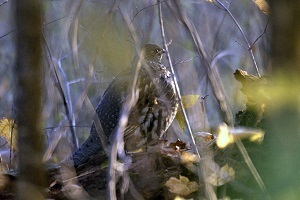|
Oct. 23, 2019
Contacts: Al Stewart (Michigan DNR), 517-896-1720; Charlotte Roy (Minnesota DNR), 218-328-8876; or Mark Witecha (Wisconsin DNR), 608-267-7861
West Nile virus survey in Great Lakes region shows limited exposure in ruffed grouse, strong survival rates

First-year results from a multistate West Nile virus study show that while the virus is present in some ruffed grouse in the Great Lakes region, most birds exposed to the virus can survive. More than 700 hunter-provided samples from Michigan, Minnesota and Wisconsin were analyzed – both for exposure and infection – in the West Nile Virus in ruffed grouse surveillance project coordinated by the natural resources departments in those three states.
Ruffed grouse hunters in Michigan were asked to collect a blood sample and provide the breasted-out carcass for the study. The blood samples were analyzed for antibodies that would indicate if the bird had been exposed to WNV. Heart tissue was tested for the presence of the virus.
- During the 2018 season, Michigan hunters submitted 213 samples from four study areas in the Upper and northern Lower peninsulas. Of these, 28 (13%) tested positive for antibodies consistent with WNV exposure. The virus was confirmed in nine (4%) birds and likely in 19 (9%). Four birds (one adult and three juveniles, all from the northern Lower Peninsula) tested positive for the presence of viral material in their hearts.
- In Wisconsin, 68 (29%) of the 235 samples were positive for antibodies consistent with virus exposure, with exposure being confirmed in 44 (19%) and likely in 24 (10%). Two birds tested positive for the virus in the heart tissue.
- In Minnesota, 34 (12.5%) of the 273 samples were positive for antibodies, while exposure was detected in 10 (3.7%) and likely in 24 (8.8%). The virus was not found in heart tissue from any of the Minnesota samples.
|
The results from this first year of a three-year study are showing that, while the virus is present in the region, exposed grouse can survive. Research in other states points to good grouse habitat as one factor that can produce birds in better condition that are better able to survive stressors like West Nile virus.
“High-quality grouse habitat is a key component to the overall health of the birds and their ability to survive diseases and other limiting factors,” said Al Stewart, upland game bird specialist with the Michigan Department of Natural Resources. Stewart also pointed to a recent Pennsylvania study showing that in areas of lower-quality habitat or where habitat is scarce, WNV may contribute to declines in ruffed grouse population.
The Pennsylvania research paper is available for purchase in the Wildlife Society's Wiley Online Library. This Young Forest Project article from November 2016 provides an overview of the study's partnerships and results.
“Participation from grouse hunters in the region is an important component of the study,” said Julie Melotti, a laboratory technician with the Michigan DNR’s Wildlife Disease Lab. “We appreciate all of the interest and efforts being made by hunters to provide samples for this study.”
Hunters who provided email contact information with their 2018 samples will be notified of their results this fall. Due to the strong interest in this study, all the kits assembled by the Michigan DNR for the 2019 season have been distributed.
Further information on WNV in ruffed grouse can be found on the Michigan DNR’s WNV and Ruffed Grouse FAQ sheet.
/Note to editors: An accompanying photo of a ruffed grouse in the Michigan forest is available below for download./
|